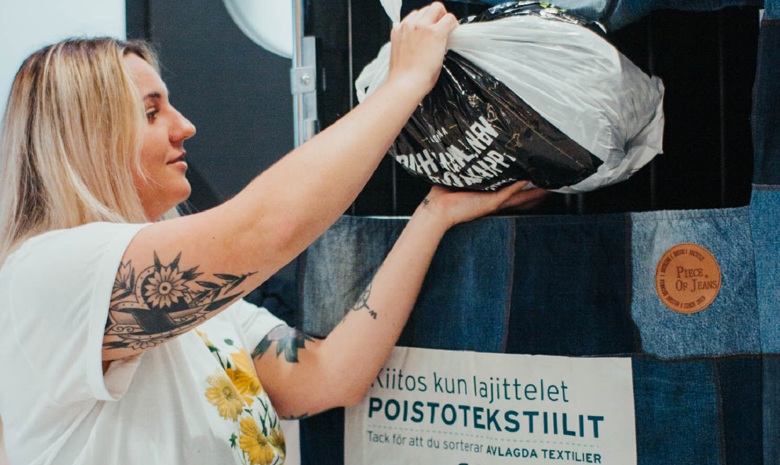Clothes and textiles

Sort clean and worn-out clothes and household textiles into HSY’s free-of-charge end-of-life textile collection points. Any clothes that are in good condition should be sold or donated to second-hand markets or reuse centres.
What can you take to end-of-life textile collection?
Yes, please
Damaged, worn-out or otherwise unusable textiles belong in end-of-life textile collection. End-of-life textile collection is best suited for, for example
- trousers, skirts and shirts
- bedsheets, towels and tablecloths.
The textiles must be clean, dry and free of mould. Pack the textiles tightly in plastic bags.
No, thank you
- Underclothes, socks and hosiery. For hygiene reasons, these should be sorted into mixed waste.
- Malodorous, mouldy, wet or oily textiles. For hygiene reasons, these should be sorted into mixed waste.
- Bedbug-contaminated textiles. See separate instructions.
- Textiles contaminated with other pests. These should be sorted into mixed waste.
- The following belong in mixed waste if damaged or in poor condition:
- carpets
- shoes, bags and belts
- pillows, duvets and mattresses
- cushions
- soft toys.
Reusable clothing and textiles
Reusable clothing, textiles, shoes, bags and belts do not belong in end-of-life textile collection. These can be sold in a second-hand market, donated to charity or delivered to other textile collection points such as the Reuse Centre.
You can find your nearest clothing collection point at Kierrätys.infoHSY’s end-of-life textile collection is intended for residents only. The collection of end-of-life textiles from businesses is organised nationwide by Rester Oy.
Step-by-step instructions:
-
1
Wash and dry dirty textiles. Any textiles sorted into end-of-life textile collection must be clean, as the textiles will not be washed during processing. Small, dry stains are acceptable.
-
2
Pack the textiles tightly in plastic bags to keep them dry and clean.
-
3
If the textiles are mouldy, wet or oily, please sort them into mixed waste.
Where should you take end-of-life textiles?
End-of-life textiles can be taken to HSY’s free-of-charge collection points.
Espoo
- Iso Omena shopping centre, Matinkylä, level P1, recycling point near the parking hall entrance below the hypermarkets.
- Sello shopping centre, Leppävaara, parking level P1, recycling point near the parking hall entrance.
- Stockmann Ainoa, Tapiola, service point on the 1st floor.
Helsinki
- Kanneltalo, Klaneettitie 5 (Sitratori), left of the main entrance.
- Kaari shopping centre, Kannelmäki, level -1, near the parking hall entrance.
- Hertsi shopping centre, Herttoniemi, P2 entrance hall.
- Kamppi shopping centre, Helsinki, near the elevators in the Annankatu entrance hall, level P.
- Stockmann Itis, Itäkeskus, 1st floor, next to the service point near the entrance.
- Stockmann Helsinki Centre, 6th floor elevator lobby and level P3 collection point.
Vantaa
- Myyrmanni shopping centre, Myyrmäki, the larger parking hall lobby on level -1.
- Stockmann Jumbo, Pakkala, children’s department on the 2nd floor.
Kirkkonummi
- Jorvas Sortti Station, register at the information desk.
You can notify our customer service about full end-of-life textile roll containers by calling (09 1561 2110).
What happens to end-of-life textiles?
We pre-sort end-of-life textiles in the Helsinki Metropolitan area. Some parts are reused. What cannot be recycled goes to the waste-to-energy plant as raw material for energy production. HSY and other waste management companies are actively exploring new ways and targets for recycling textile waste.
Why are there only so few collection points?
HSY does not intend to increase the number of end-of-life textile collection points in the Helsinki Metropolitan Area, as the collection of end-of-life textiles will most likely be taken over by textile producers, i.e. textile manufacturers and importers. This means that manufacturers would also be responsible for recycling end-of-life textiles. Since the allocation of responsibilities over collection is at the moment unclear, HSY is not planning to increase the number of collection points in the Helsinki Metropolitan Area.
As end-of-life textiles must be sorted manually, the cost of collecting and processing textiles is manifold compared to other types of waste. Additionally, no further use currently exists for certain types of fibre, and they are used in energy production instead of being recycled.